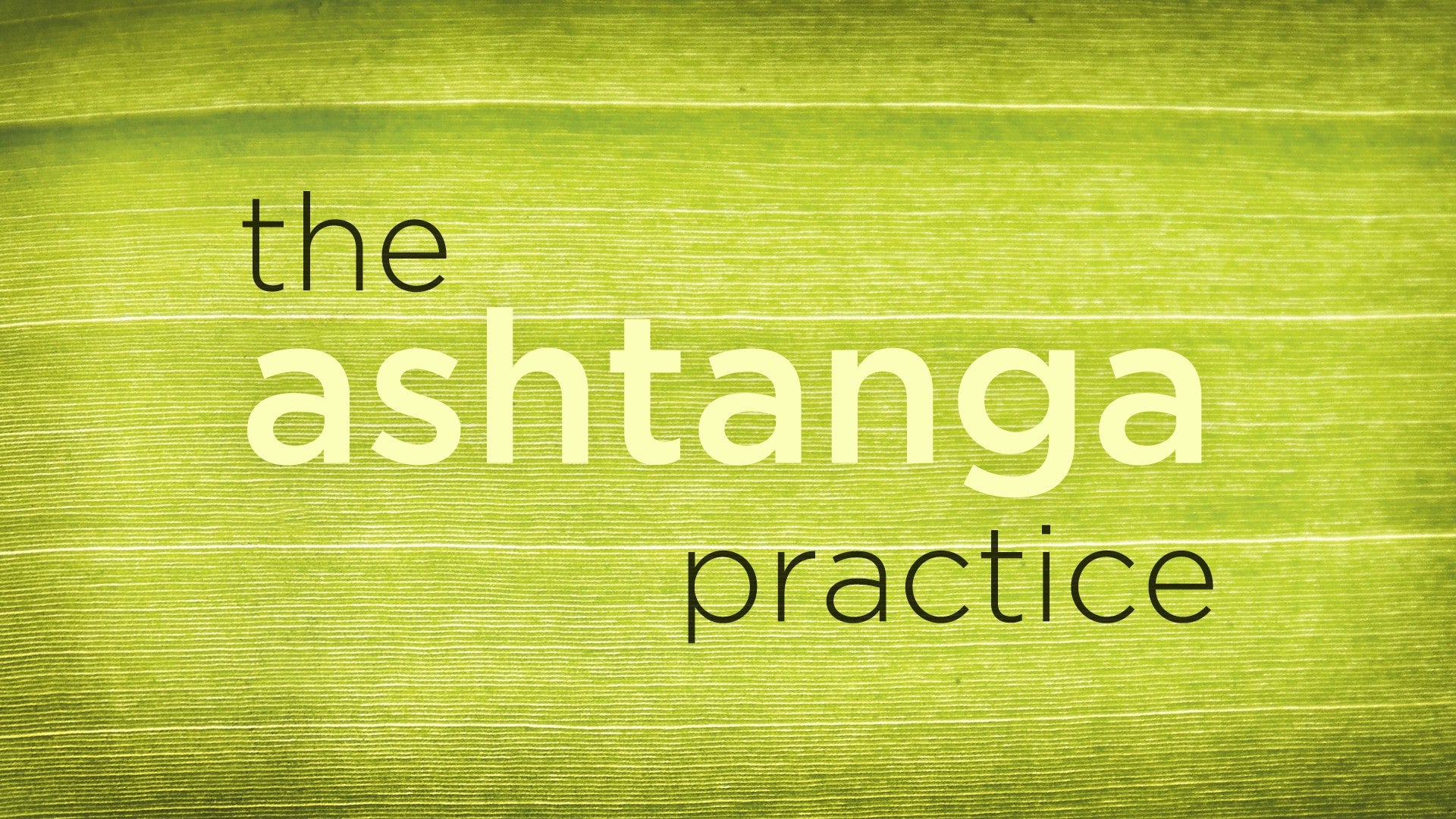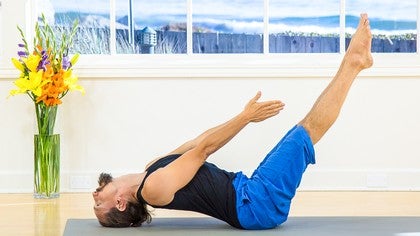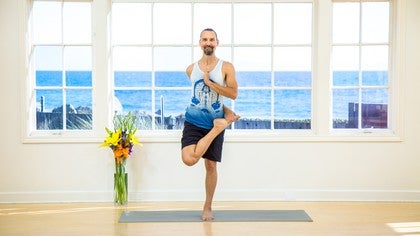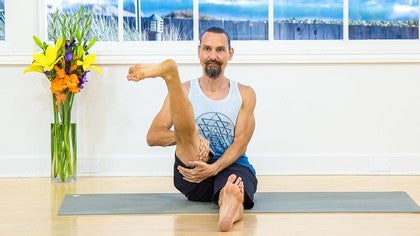Description
About This Video
Transcript
Read Full Transcript
Wonderful, you have finished your practice for the day, but you're not finished really until we do finishing asanas, where we get a great chance to go upside down, going into inversions, we'll help to detoxify. But more importantly, we'll also help to draw awareness back internally, where we want to keep awareness centered throughout the practice. So wherever your asana practice has gone for the day, we will now go to back bends and finishing poses. So you could take a vinyasa with me here, and we'll jump through to Urdhva Dhanurasana. From Downward Dog, Sapta, inhale, jump through, and with straight legs, exhale, lie down on your back.
Ashta, prepare, bend your knees, put your feet flat upon the floor, a little bit wider than the hips, with feet absolutely parallel, and knees staying close. And then Nava, inhale and come up. You might have the hands already behind the shoulders, or you might be taking the modified bridge-like posture, rolling the shoulders under, interlacing the fingers, one, still grounding through the root knuckles of the big toe mounds, two, with the fingers spread, three. You may also find yourself in the full Urdhva Dhanurasana, four, keeping Udiya Nambanda and Mulabanda with you, five, dasha, exhale, you could come down upon your head, take rest, or walk your hands in a little more if you're comfortable with it. Exhaling completely, and Nava, inhale, come up for the second one, one, your arms moving towards a straightened position, two, lower back in absolute comfort, three, if it's not, come down and find a comfortable position, four, modifying however you like, and five, dasha, exhale, come down, walk the hands in more if you like, and Nava, inhale, come up, last one, one, two, feet parallel, knees close, three, hands parallel, elbows closeening, four, and five, you could stand up or come down upon your back, and from there, either chakrasana or roll up to the front of the mat and do a regular vinyasa, inhaling to lift, nakadasa, jumping back, chaturanga, dvadasa, inhale, upward facing dog, triyudasa, real downward facing dog, the final finishing inversions, if you're doing drop backs, of course you'd put them here, the rest of us will go to salambha-saravangasana sequence, shoulder stance, up to inhale, jump through, straight legs sit down, in dandasana and with straight legs, you can use any counter pose that works for you here, traditionally we do pashimatanasana, inhale reaching forward with a long spine, and ashta, exhale slowly and gently moving towards a forward bend, making sure that everything is feeling just fine and lower back after the back bend, if at any point things feel numb, tingly, tense, painful, come up, use bandha and just be there, two, or if it's really comfortable for you, just going deep into a full forward fold, four, five, six, seven, eight, nine, ten, ten, dasha, inhale, head up, exhale, let go, cross the legs, plant the hands, akarasha, inhale, lift up, dvadasa, exhale, jump back, chaturanga, triyugdasa, inhale, upward facing dog, chaturgasa, exhale, downward facing dog, and now we'll go into the finishing inversion, salambasar vangasana sequence, sapta, inhale, jump through straight legs, sit down, and with straight legs, exhale, lie down on your back, and take some breaths here, refining and refining mula and udiyana bandha, keeping bandhas, finding that even flow of breath, you can already draw the drishti, gazing down the tip of the nose, and if you're menstruating, it's your moon cycle time of the month, you could take viparita karani with your feet up the wall, or otherwise, ashta, inhale, draw your hips above your shoulders, hands on lower back, and the legs reaching straight up towards the sky, one, drishti down the tip of the nose, drawing awareness internal, two, you'll be tempted to look at your big toes, just try and draw the awareness down, three, maybe looking at udiyana bandha, the home site, four, somewhere below the navel, five, it may be that you roll the shoulders under more deeply, six, making sure to keep weight off of the cervical vertebrae as detailed in the shoulder stand tutorial, seven, eight, nine, ten, halasana, keeping the drishti on the tip of the nose, exhaling, drawing the straight legs back behind the head, if the feet are floating, keep your hands on lower back, if the feet can comfortably take the mat, point your toes, toenails on the mat, one, interlacing your fingers, rolling the shoulders under a little more deeply, two, so each side of the shoulders is grounding actively into the mat, three, and keeping the space between the shoulder blades, four, cervical vertebrae lifted and protected, five, six, seven, eight, karnapadasana, exhaling, keep the feet flat on the floor and bend the knees and let the knees go down into the ears if they can, one, still the drishti down the tip of the nose, two, if the knees don't reach the ears comfortably, they might be three, resting on the forehead, four, and the hands can always support the lower back if needed, five, six, maybe you can even squeeze the knees into the ears, seven, so they become like earplugs amplifying the sound of your own breath, smoothing it out, eight, return the hands to lower back and with straight legs inhale, draw your legs back straight up towards the sky, urdhapadasana, nava, exhale, crossing the legs here into lotus or half lotus or any comfortable cross-legged position, maybe you get the palms onto the knees, lifting with straightened arms, two, still keeping weight through the shoulders, three, to keep the cervical vertebrae protected and lifted, four, five, six, seven, eight, exhaling into pindasana, let the knees drop towards the head, wrap the elbows outside the knees and clasp the hands if you can, one, two, three, four, five, six, seven, eight, matzias, nava, inhale, and roll the spine down the mat.
If you're uncomfortable in lotus, stay in lotus or cross legs, if you want to take a fish position with straight legs, that's fine. Keeping the hands out from under the bum so the hands are free, arch the spine up towards the mat, one, lift the top of the head, take the mat, two, and maybe your hands take the tops of the feet, three, if you're comfortable in lotus, pulling the feet, four, so that you lift the spine higher, five, the left knee journeying down towards the mat, six, and drishti here up towards the eyebrow center, seven, eight, udon padasana, inhaling, raise your hands together about a 45 degree angle, raise your feet together about the same angle, one, if it hurts your lower back, maybe one foot is on the mat, two, or both feet if needed, three, drishti down the tip of the nose, four, five, six, seven, eight, keeping the limbs lifted, exhale, let the spine roll down the mat. And you can chakrasana or roll up to the front of the mat, dashta, inhaling to lift, and exhaling to find chaturanga, ekadasana, inhale, upward facing dog, drishti, exhale, downward facing dog, shishasana, headstand, sapta, prepare. So if you're familiar with headstand, ashta, inhale, come up. If you're not yet feeling comfortable, keep your two elbows, forearms, and hands pushing down in the mat, three, as if you're squeezing a little tennis ball in between the hands, four, let the back of the head push into the thumbs, five, and maybe you're just in a position here, six, lifting the hips above the shoulders, seven, maybe experimenting with one foot or even both feet, eight, keeping weight off of the head by pushing nine elbows in the mat, 10, 11, 12, 13, 14, 15, 16, 17, 18, 19, 20, 21, 22, 22, 23, 24, 24, 25, 26, 27, 27, 28, 28, 29, 30, 30, 31, 32, 33, 33, 34, 35, 36, 37, 37, 38, 39, 40, 41, 42, 43, 42, 43, 43, 44, 45, 45, 46, 47, 48, 48, 49, 49, 50, 50, 51, 52, 52, 53, 52, 53, 52, 53, 52, 55, 55, 55, 56, 68, 56, 55, 56, 56, 56, 56, 56, 58, 59, 59, 61, 1, 2, 3, 6, 1.
1, 2, 3, 4, 6, 1, 2, 3, 4, 6, 1, 2, 3, 5, 6, 5, 6, 6, 7, 7, 8, 9, 10. Now, inhale, come all the way back up to headstand, fully exalted there. When ready, Dasha exhale, slowly control the descent and come down, putting the feet on the floor, bending the knees, keeping the hands where they are, dropping the head back towards the knees on the mat as you take rest. Give yourself a deep rest here, letting the shoulders release, and then a kadashah, spreading the fingers, inhaling, fingers at the front corners of the mat, and exhale, step back, chaturanga dandasana, dvarasana, inhale, upward-facing dog, triyogdasha, exhale, downward-facing dog. The final seated finishing posture is sapta, inhale, come through, dandasana, and then exhaling, take yourself to a lotus, half lotus, or simple cross legs, whatever you're most comfortable in, and bind your hands behind you in some way, maybe the elbows are taken by each hand, or if you're able, binding the top of the feet in badapadmasana, ashta, then inhale, raise the drishti up to the eyebrow center, or simply look up towards the top of the eyes, yoga mudra, nava, exhale, folding forward, keeping the drishti lifted, and breathe.
One, so even as the body journeys forward and downward into the earth, two, the awareness rises freely, four, the seal of yoga, five, sealing in to purifying benefits, six, as well as signaling, seven, which your intensive asana practice is finished for this session, eat, nine, 10, dasana, inhale, come up, and release the hands from their bound position, and take a padmasana variation, either in full or half lotus or simple cross legs, take chin mudra, index finger and thumb, lightly touching one another, the other three fingers extend on each hand, and dropping the chin towards the chest, one lifting the chest towards the chin, two looking down the tip of the nose, three, mula bandha, udhyana bandha, four, five, if you're working with a pranayama practice and a pranayama teacher, six, this would be a great place to insert that, seven, eat, otherwise just measuring the flow of breath at the back of the throat, nine, ten, udplutihi, planting the hands next to the hips, inhale and lift up, one keeping the flow of breath smooth and controlled, two, three, four, drishti low, down the tip of the nose, five, or looking down at the floor in front, six, lift up, seven, eight, nine, and ten, exhale and come down, you could jump back chaturanga dandasana or step yourself back however it works, inhaling, upward facing dog, exhale, downward facing dog, and we'll finish from the floor today, so again, sapta inhale, jump through, straight legs, sitting down, and then from there we will do the closing mantra, a prayer that basically offers our entire practice forth as a work of service, that in some way we hope that this practice not only serves ourself of course, but that it hopes to bring about a more refined experience for ourselves, that our daily interactions may help others feel more joy and more freedom in their daily life, ancient ancient prayer basically saying that this practice isn't just about one individual but we're helping to uplift all, you can join me if you like or simply listen with that in mind. Go brahmanebiya shubhamastu nityam lokasamastasukinhu bhavantu om shanti shanti shanti may this practice serve all well thank you for participating and now we should lie down and take rest an important part of the practice not to be skipped let your feet roll out to the side let your spine find the mat let your palms flip open to the sky and absolutely completely let go we release all the fundamental aspects of the ashtanga asana practice letting go of the muscular engagements of udiana and mula bandha so the belly is free to rise and fall with breath letting go of any posture or postural alignment techniques so limbs are free to roll or rotate wherever gravity directs them and letting go of any specific drishti or gazing point so the eyes are closed and the mind is free to wander as you take a deep full rest so so so so so so so still completely at rest just notice how the breath naturally moves the body even without managing the flow of breath inhales are naturally expansive and exhales naturally draw you closer to the earth grounding with your next inhale you could allow some movement to come through the limbs of course if you want to take a longer rest please feel free stay lying down breathing comfortably as long as you like if you're feeling ready to bring some gentle subtle and relaxed movements back through the body move the limbs the neck and head and eventually inhale and stretch really long and exhale roll over onto one side or the other taking a fetal position there and giving yourself some space and time to do nothing and then gently when you're ready you can bring yourself back up to a seated position again feel free to stay resting longer if you like it's brilliant that you've been able to make it all the way through this practice i have a feeling if you've made it all the way to this point you must have taken on a dedicated and regular ashtanga practice and a dedicated and regular yoga practice i truly hope that that can be of service to you keep watching keep practicing if you have questions be in touch may these practices serve you well
The Ashtanga Practice: Dylan Bernstein
Comments
You need to be a subscriber to post a comment.
Please Log In or Create an Account to start your free trial.










